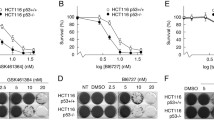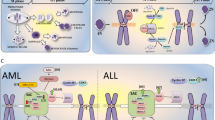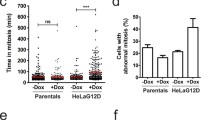Abstract
Background
At therapeutic concentrations, the antineoplastic agent taxol selectively perturbs mitotic spindle microtubules. Taxol has recently been shown to induce apoptosis, similar to the mechanism of cell death induced by other antineoplastic agents. However, taxol has shown efficacy against drug-refractory cancers, raising the possibility that this pharmacological agent may trigger an alternative apoptotic pathway.
Materials and Methods
The kinetics and IC50 of mitotic (M) block, aberrant mitosis, and cytotoxicity following taxol treatment were analyzed in human cell lines as well as normal mouse embryo fibroblasts (MEFs) and MEFs derived from p53-null mice. Apoptosis was followed by DNA gel electrophoresis and by in situ DNA end-labeling (TUNEL).
Results
Taxol induced two forms of cell cycle arrest: either directly in early M at prophase or, for those cells progressing through aberrant mitosis, arrest in G1 as multimininucleated cells. TUNEL labeling revealed that DNA nicking occurred within 30 min of the arrest in prophase. In contrast, G1-arrested, multimininucleated cells became TUNEL positive only after several days. In the subset of cells that became blocked directly in prophase, both wt p53-expressing and p53-null MEFs responded similarly to taxol, showing rapid onset of DNA nicking and apoptosis. However, p53-null MEFs progressing through aberrant mitosis failed to arrest in the subsequent G1 phase or to become TUNEL positive, and remained viable.
Conclusions
Taxol induces two forms of cell cycle arrest, which in turn induce two independent apoptotic pathways. Arrest in prophase induces rapid onset of a p53-independent pathway, whereas G1-block and the resulting slow (3–5 days) apoptotic pathway are p53 dependent.











Similar content being viewed by others
References
Schiff PB, Horwitz SB. (1980) Taxol stabilizes microtubules in mouse fibroblast cells. Proc. Natl. Acad. Sci. U.S.A. 77: 1561–1565.
Schiff PB, Horwitz SB. (1981) Taxol assembles tubulin in the absence of exogenous guanosine 5-triphosphate or microtubule-associated proteins. Biochemistry 20: 3247–3252.
Manfredi JJ, Horowitz SB. (1984) Taxol: An antimitotic agent with a new mechanisms of action. Pharmacol. Ther. 25: 83–125.
Manfredi JJ, Parness J, Horwitz SB. (1982) Taxol binds to cellular microtubules. J. Cell Biol. 94: 688–696.
De Brabander M, Geuens G, Nuydens R, Willebrords R, De Mey J. (1981) Taxol induces the assembly of free microtubules in living cells and blocks the organizing capacity of the centrosomes and kinetochores. Proc. Natl. Acad. Sci. U.S.A. 78: 5608–5612.
De Brabander M, Geuens G, Nuydens R, Willebrords F, Aerts F, DeMey J. (1986) Microtubule dynamics during the cell cycle: The effects of taxol and nocodazole on the microtubule system of Pt K2 cells at different stages of the mitotic cycle. In: Bourne GH, Danielli JF, Jeon KW, (eds). Int. Review of Cytology. Academic Press, Orlando, pp. 215–274.
Howard WD, Timasheff SN. (1988) Linkages between the effects of taxol, colchicine, and GTP on tubulin polymerization. J. Biol. Chem. 263: 1342–1346.
Rowinsky EK, Donehower RC, Jones RJ, Tucker RW. (1988) Microtubule changes and cytotoxicity in leukemic cell lines treated with taxol. Cancer Res. 48: 4093–4100.
McGuire WP, Rowinsky EK, Rosenshein NB, et al. (1989) Taxol: A unique antineoplastic agent with significant activity in advanced ovarian epithelial neoplasms. Ann. Intern. Med. 111: 273–279.
Rowinsky EK, Cazenave LA, Burke PJ, et al. (1989) Phase I and pharmacodynamic study of taxol in refractory acute leukemias. Cancer Res. 49: 4640–4647.
Adler LM, Herzog TJ, Williams S, Rader JS, Mutch DG. (1994) Analysis of exposure times and dose escalation of paclitaxel in ovarian cancer cell lines. Cancer 74: 1891–1898.
Holmes FA, Walters RS, Theriault RL, et al. (1991) Phase II trial of taxol, an active drug in the treatment of metastatic breast cancer. J. Natl. Cancer Inst. (U.S.A.) 83: 797–805.
Ettinger DS. (1993) Overview of paclitaxel (Taxol) in advanced lung cancer. Sem. Oncology 20: 46–49.
Wiernik PH, Schwartz EL, Einzig A, Strauman JJ, Lipton RB, Dutcher JP. (1987) Phase I trial of taxol given as a 24-hour infusion every 21 days: Responses observed in metastatic melanoma. J. Clin. Oncol. 5: 1232–1239.
Einzig AI, Hochster H, Wiernik PH, et al. (1991) A phase II study of taxol in patients with malignant melanoma. Inv. New Drugs 9: 59–64.
Forastiere AA. (1993) Use of paclitaxel (Taxol) in squamous cell carcinoma of the head and neck. Sem. Oncology 20: 56–60.
Dustin P. (1984) Microtubules. 2nd Ed. Springer-Verlag, Berlin.
Jordan MA, Toso RJ, Thrower D, Wilson L. (1993) Mechanism of mitotic block and inhibition of cell proliferation by taxol at low concentrations. Proc. Natl. Acad. Sci. U.S.A. 90: 9552–9556.
Kung AL, Sherwood SW, Schimke RT. (1990) Cell line-specific differences in control of cell cycle progression in the absence of mitosis. Proc. Natl. Acad. Sci. U.S.A. 87: 9553–9557.
Kung AL, Zetterberg A, Sherwood AW, Schimke RT. (1990) Cytotoxic effects of cell cycle phase specific agents: a result of cell cycle perturbation. Cancer Res. 50: 7307–7314.
Liebmann JE, Cook JA, Lipschultz C, Teague D, Fisher J, Mitchell JB. (1993) Cytotoxic studies of paclitaxel (Taxol) in human tumour cell lines. Br. J. Cancer 68: 1104–1109.
Sherwood SW, Sheridan JP, Schimke RT. (1994) Induction of apoptosis by the antitubulin drug colcemid: Relationship of the mitotic checkpoint control on the induction of apoptosis in HeLa S3 cells. Exp. Cell Res. 215: 373–379.
Bailly E, Dorée M, Nurse P, Bornens M. (1989) p34cdc2 located in both nucleus and cytoplasm; Part is centrosomally associated at G2/M and enters vesicles at anaphase. E.M.B.O. J. 8: 3985–3995.
Brinkley BR. (1985) Microtubule organizing centers. Annu. Rev. Cell Biol. 1: 145–172.
Verde F, Labbé J, Dorée M, Karsenti E. (1990) Regulation of microtubule dynamics by cdc2 protein kinase in cell-free extracts of Xenopus eggs. Nature 343: 223–238.
Fuchs DA, Johnson RK. (1978) Cytologic evidence that taxol, an antineoplastic agent from Taxus brevifolia, acts as a mitotic spindle poison. Cancer Treat. Rep. 62: 1219–1224.
Liebmann JE, Cook JA, Lipschultz C, Teague D, Fisher J, Mitchell JB. (1994) The influence of Cremophor E.L. on the cell cycle effects of paclitaxel (Taxol) in human cell lines. Cancer Chemother. Pharmacol. 33: 331–339.
Lopes NM, Adams EG, Pitts TW, Bhuyan KB. (1993) Cell kill kinetics and cell cycle effects of taxol on human and hamster ovarian cell lines. Cancer Chemother. Pharmacol. 32: 235–242.
Hruban RH, Yardley JH, Donehower RC, Boitnott JK. (1988) Epithelial necrosis in the gastrointestinal tract associated with polymerized microtubule accumulation and mitotic arrest. Cancer 63: 1944–1950.
Rowinsky EK, Eisenhauer EA, Chaudhry V, Arbuck SG, Donehower RC. (1993) Clinical toxicities encountered with paclitaxel (Taxol). Semin. Oncol 20: 1–5.
Stearns M, Wang M. (1992) Taxol blocks processes essential for prostate tumor cell growth, invasion and metastases. Cancer Res. 52: 3776–3781.
Kerr JFR, Wyllie AH, Currie AR. (1972) Apoptosis: A basic biological phenomenon with wide-ranging implications in tissue kinetics. Br. J. Cancer 26: 239–257.
Wyllie AH. (1981) Cell death: A new classification separating apoptosis from necrosis. In: Bowen ID, Lockshin RA, (eds.). Cell Death in Biology and Pathology. Chapman & Hall, London, pp. 9–34.
Wyllie AH. (1994) Death from inside out: an overview. Phil Trans. Royal Soc. London (B) 345: 237–241.
Sachs L, Lotem J. (1992) Control of programmed cell death in normal and leukemic cells: New implications for therapy. Blood 82: 15–21.
Schwartzman RA, Cidlowski JA. (1993) Apoptosis: The biochemistry and molecular biology of programmed cell death. Endocr. Rev. 14: 133–151.
Barry MA, Behnke CA, Eastman A. (1990) Activation of programmed cell death (apoptosis) by cisplatin, other anticancer drugs, toxins and hyperthermia. Biochem. Pharmacol 40: 2353–2362.
Hickman JA, Potten CS, Merritt AJ, Fisher TC. (1994) Apoptosis and cancer chemotherapy. Phil Trans. Royal Soc. London (B) 343: 319–325.
Sen S, D’Incalci M. (1992) Biochemical events and relevance to cancer chemotherapy. Fed. Eur. Biochem. Soc. Lett. 307: 122–127.
Demarcq C, Bunch RT, Creswell D, Eastman A. (1993) The role of cell cycle progression in cisplatin-induced apoptosis in Chinese hamster ovary cells. Cell Growth Diff. 5: 983–993.
O’Connor PM, Ferris DK, White GA, et al. (1992) Relationships between cdc2 kinase, DNA cross-linking and cell cycle perturbations induced by nitrogen mustard. Cell Growth Diff. 3: 43–52.
Lowe SW, Ruley HE, Jacks T, Housman DE. (1993) p53-Dependent apoptosis modulates the cytotoxicity of anticancer agents. Cell 74: 957–967.
Kastan MB, Onyekwere O, Sidransky D, Vogelstein B, Craig RW. (1991) Participation of p53 protein in the cellular response to DNA damage. Cell 74: 957–967.
Nelson WG, Kastan MB. (1994) DNA strand breaks: The DNA template alterations that trigger p53-dependent DNA damage response pathways. Mol Cell Biol. 14: 1815–1823.
El-Deiry WS, Tokino T, Velculescu VE, et al. (1993) WAF1, a potential mediator of p53 tumor suppression. Cell 75: 817–825.
Gu Y, Turc CW, Morgan DO. (1993) Inhibition of CDK2 activity in vivo by an associated 20K regulatory subunit. Nature 366: 707–710.
Harper JW, Adami GR, Wei N, Keyomarsi K, Elledge SJ. (1993) The p21 Cdk-interacting protein Cip 1 is a potent inhibitor of G1 cyclin-dependent kinases. Cell 75: 805–816.
Dulic W, Kaufmann WK, Wilson SJ, et al. (1994) p53-dependent inhibition of cyclin-dependent kinase activities in human fibroblast during radiation-induced G1 arrest. Cell 76: 1013–1033.
Fritsche M, Haessler C, Brandner G. (1993) Induction of nuclear accumulation of the tumor suppressor protein p53 by DNA-damaging agents. Oncogene 8: 307–318.
Lu X, Lane DP. (1993) Differential induction of transcriptionally active p53 following UV or ionizing radiation: defects in chromosome instability syndromes? Cell 75: 765–778.
Clarke AR, Purdie CA, Harrison DJ, et al. (1993) Thymocyte apoptosis induced by p53-dependent and independent pathways. Nature 362: 849–852.
Lee JM, Bernstein A. (1993) p53 mutations increase resistance to ionizing radiation. Proc. Natl Acad. Sci. U.S.A. 90: 5742–5746.
Lowe SW, Schmitt EM, Smith SW, Osborne BA, Jacks T. (1993) p53 is required for radiation-induced apoptosis in mouse thymocytes. Nature 362: 847–849.
El-Deiry WS, Harper JW, O’Connor PA, et al. (1994) WAF1/Cip1 is induced in p53-mediated G1 arrest and apoptosis. Cancer Res. 53: 1168–1174.
Levine AJ, Momand J, Finlay CA. (1991) The p53 tumour suppressor gene. Nature 351: 453–456.
Fearon ER, Vogelstein B. (1990) A genetic model for colorectal tumorigenesis. Cell 61: 759–767.
Hollstein M, Sidransky D, Vogelstein B, Harris CC. (1991) p53 Mutations in human cancers. Science 253: 49–53.
Sidransky D, Mikkelsen T, Schwechheimer KM, Rosenblum L, Cavanee W, Vogelstein B. (1992) Clonal epansion of p53 mutant cells is associated with brain tumour progression. Nature 355: 846–847.
Hartwell L. (1992) Defects in a cell cycle Checkpoint may be responsible for the genomic instability of cancer cells. Cell 71: 543–546.
Jenkins JR, Rodge K, Chumskev P, Currie GA. (1986) The cellular oncogene p53 can be activated by mutagenesis. Nature 317: 816–818.
Yin Y, Tainsky MA, Bischoff FZ, Strong LC, Wahl GM. (1992) Wild-type p53 restores cell cycle control and inhibits gene amplication in cells with mutant p53 alleles. Cell 70: 937–948.
Perry ME, Levine AJ. (1994) p53 and mdm-2: Interactions between a tumor suppressor gene and oncogene product. Mt. Sinai J. Med. 61: 291–299.
Zambetti GP, Levine AJ. (1993) A comparison of biological activities of wild type and mutant p53. F.A.S.E.B. J. 7: 855–865.
Dittmer D, Patti S, Zambetti G, et al. (1993) Gain of function mutations in p53. Nature Genet. 4: 42–46.
Sturzbecker HW, Brain R, Addison C, et al. (1992) A C-terminal α-helix plus basic region motif is the major structural determinant of p53 tetramerization. Oncogene 7: 1513–1523.
Donehower LA, Harvey M, Slagle BL, et al. (1992) Mice deficient for p53 are developmentally normal but susceptible to spontaneous tumours. Nature 356: 215–221.
Symonds H, Krall L, Remington L, et al. (1994) p53-Dependent apoptosis suppresses tumor growth and progression in vivo. Cell 78: 703–711.
Berges RR, Furuya Y, Remington L, English HF, Jacks T, Isaacs JT. (1993) Cell proliferation, DNA repair and p53 function are not required for programmed death of prostatic glandular cells induced by androgen ablation. Proc. Natl. Acad. Sci. U.S.A. 90: 8910–8914.
Bhalla K, Ibrado AM, Tourkina E, Tang C, Mahoney ME, Huang Y. (1993) Taxol induces internucleosomal DNA fragmentation associated with programmed cell death in human myeloid leukemia cells. Leukemia 7: 563–568.
Willingham MC, Bhalla K. (1994) Transient mitotic phase localization of Bcl-2 oncoprotein in human carcinoma cells and its possible role in prevention of apoptosis. J. Histochem. Cytochem. 42: 441–450.
Donaldson KL, Goolsby G, Kiener PA, Wahl AF. (1994) Activation of p34cdc2 coincident with taxol-induced apoptosis. Cell Growth Differen. 5: 1041–1050.
Gavrieli Y, Sherman Y, Ben-Sasson SA. (1992) Identification of programmed cell death in situ via specific labeling of nuclear DNA fragmentation. J. Cell Biol. 119: 493–501.
Bollag D, McQueney PA, Zhu J, Hensens O, Koupal L, Liesch J, Goetz M, Lazarides E, Woods CM. (in press) Epothilones: A novel class of microtubule stabilizing agents with a taxol-like mechanism of action. Cancer Res. 55: 2325–2333.
Xiong Y, Hannon GJ, Zhang H, Casso D, Kobayashi R, Beach D. (1993) p21 is a universal inhibitor of cyclin kinases. Nature 366: 701–704.
Cross SM, Sanchez CA, Morgan CA, et al. (1995) A p53-dependent mouse spindle checkpoint. Science 267: 1363–1367.
Runnebaum IB, Nagarajan M, Bowman M, Soto D, Sukumar S. (1991) Mutations in p53 as potential molecular markers for human breast cancer. Proc. Natl. Acad. Sci. U.S.A. 88: 10657–10661.
Sheikh MS, Li X, Chen J, Shao Z, Ordonez JV, Fontana JA. (1994) Mechanisms of regulation of WAF1/Cip1 gene expression in human breast carcinoma: Role of p53-dependent and independent signal transduction pathways. Oncogene 9: 3407–3415.
Shi L, Nishioka WK, Th’ng J, Bradbury EM, Lichfiel DW, Greenberg AH. (1994) Premature p34cdc2 activation required for apoptosis. Science (Wash. D.C.), 263: 1143–1145.
Hoang AT, Cohen KJ, Barrett JF, Bergstrom DA, Dang CV. (1994) Participation of cyclin A in Myc-induced apoptosis. Proc. Natl. Acad. Sci. U.S.A. 91: 6875–6879.
Meikrantz W, Gisselbrecht S, Tam SW, Schlegel R. (1994) Activation of cyclin A-dependent protein kinases during apoptosis. Proc. Natl. Acad. Sci. U.S.A. 91: 3754–3758.
Russell P, Nurse P. (1987) Negative Regulation of Mitosis by wee1+, a gene encoding a protein kinase homolog. Cell 49: 559–567.
Heald R, McLoughlin M, McKeon F. (1993) Human Wee1 maintains mitotic timing by protecting the nucleus from cytoplasmically activated Cdc2 kinase. Cell 74: 463–474.
Acknowledgments
We greatly appreciate the assistance of Judy Miller in carrying out FACS analysis and also thank J. Xu for helpful discussions on the TUNEL method and Dr. Helen Ranney for valuable input during the completion of this manuscript.
Author information
Authors and Affiliations
Rights and permissions
About this article
Cite this article
Woods, C.M., Zhu, J., McQueney, P.A. et al. Taxol-Induced Mitotic Block Triggers Rapid Onset of a p53-Independent Apoptotic Pathway. Mol Med 1, 506–526 (1995). https://doi.org/10.1007/BF03401588
Published:
Issue Date:
DOI: https://doi.org/10.1007/BF03401588




